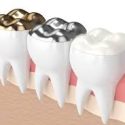
|

|

|

|

Fillings 101: 10 Patient’s Guide to Dental Restorations
1. Understanding Dental Fillings
Dental fillings are used to restore teeth damaged by decay. They fill the cavity left after removing the decayed part of the tooth, preventing further damage and restoring the tooth’s function and appearance. Choosing the right type of filling and maintaining it properly is crucial for longevity.2. Types of Dental Fillings
There are several types of dental fillings, including amalgam, composite resin, gold, and porcelain. Each type has its benefits and drawbacks. For example, amalgam fillings are durable but noticeable, while composite fillings blend in with your teeth but may not last as long.3. Choosing the Right Filling for You
Your dentist will recommend the best type of filling based on the location of the cavity, the extent of the decay, and your personal preferences. Discussing your options with your dentist ensures you get a filling that meets your needs for aesthetics and durability.4. The Filling Procedure
The dental filling procedure typically involves removing the decayed portion of the tooth, cleaning the area, and then filling it. The process is usually quick and painless, thanks to modern anaesthesia. Understanding what to expect can alleviate any anxiety you may have.5. Post-Filling Care
Proper care after getting a dental filling is crucial. Avoid eating hard or sticky foods immediately after the procedure, and follow your dentist’s instructions on oral hygiene. Regular brushing, flossing, and dental check-ups will help keep your fillings in good condition.6. How Long Do Dental Fillings Last?
The lifespan of a dental filling depends on the material used and how well you care for it. Amalgam fillings can last up to 15 years, while composite fillings typically last 5-7 years. Maintaining good oral hygiene and avoiding habits like teeth grinding can extend the life of your fillings.7. Signs Your Filling Needs Replacement
Over time, fillings can wear down or become damaged. Common signs that a filling needs replacement include sensitivity to hot or cold, a visible crack or chip in the filling, or pain when chewing. Regular dental visits can help catch these issues early.8. Preventing Future Cavities
To minimise the need for future fillings, it’s essential to prevent cavities. Brush your teeth twice a day, floss daily, and limit sugary snacks and drinks. Using fluoride toothpaste and visiting your dentist regularly for cleanings and check-ups can also help.9. Diet and Dental Fillings
What you eat can impact the longevity of your dental fillings. Avoid hard, sticky, or sugary foods that can damage your fillings or promote decay. A balanced diet rich in fruits, vegetables, and calcium can help maintain your overall oral health.10. Regular Dental Check-Ups
Regular dental check-ups are vital for maintaining your fillings and overall oral health. Your dentist can monitor the condition of your fillings, catch any issues early, and provide professional cleanings that keep your teeth and fillings in top shape.Conclusion
Dental fillings are an effective solution for treating cavities and restoring your smile. By understanding the different types of fillings, how to care for them, and what to expect from the procedure, you can ensure your dental fillings last as long as possible. Maintaining good oral hygiene, eating a healthy diet, and visiting your dentist regularly are key to keeping your fillings and your smile in excellent condition. Feel free to reach out to your dentist if you have any questions or concerns about your dental fillings. They can provide personalised advice and ensure you receive the best care for your dental health.Ensure Your Fillings Last Longer!
Keep your smile healthy and your dental fillings in perfect condition with regular check-ups at Alphington Dental Care. Our expert team is here to provide personalised care and advice for all your dental needs. Book your appointment today! Your smile deserves the best—trust us to help you maintain it!Frequently Asked Question
Teeth whitening is the most common cosmetic dental procedure. It allows people to make noticeable improvements to their smile without undergoing invasive treatments.
Technology has become an integral aspect of modern dentistry, completely transforming both the patient experience and treatment outcomes. Digital X-rays, 3D imaging, CAD/CAM systems, laser dentistry, and guided surgery have revolutionized how dental professionals diagnose, plan, and carry out treatments.
The term “”root canal”” is widely recognized, often portrayed in movies, TV shows, and pop culture as an extremely painful procedure. This portrayal has instilled fear in many people, leading some to avoid visiting the dentist altogether when they suspect they may need a root canal.





